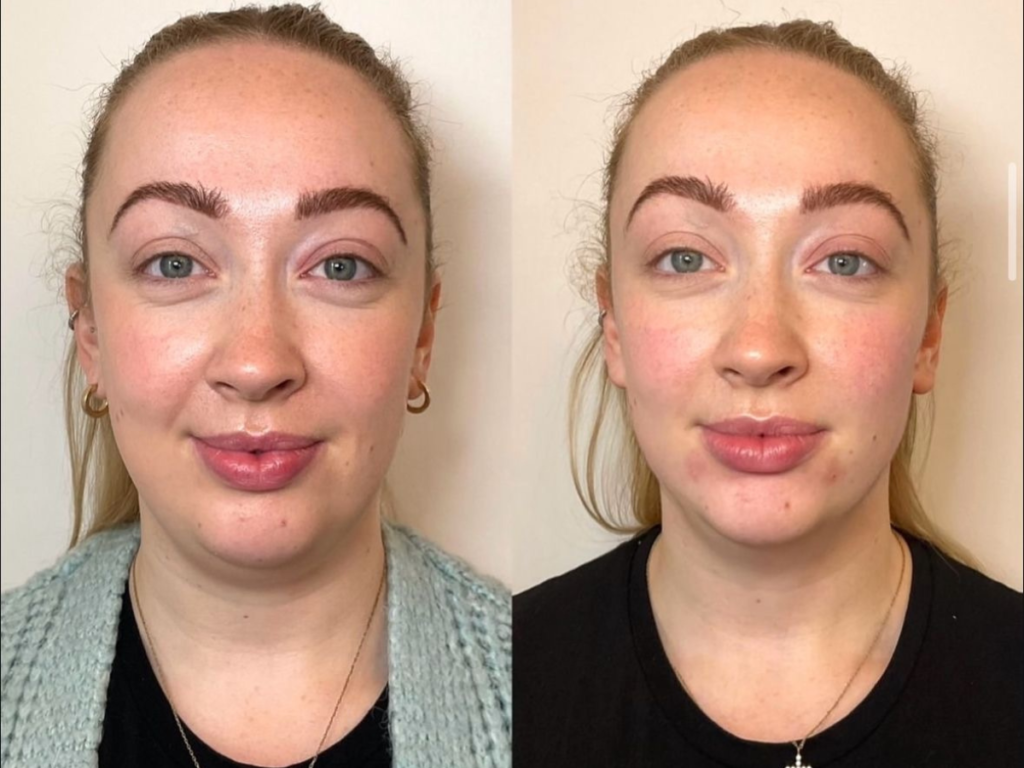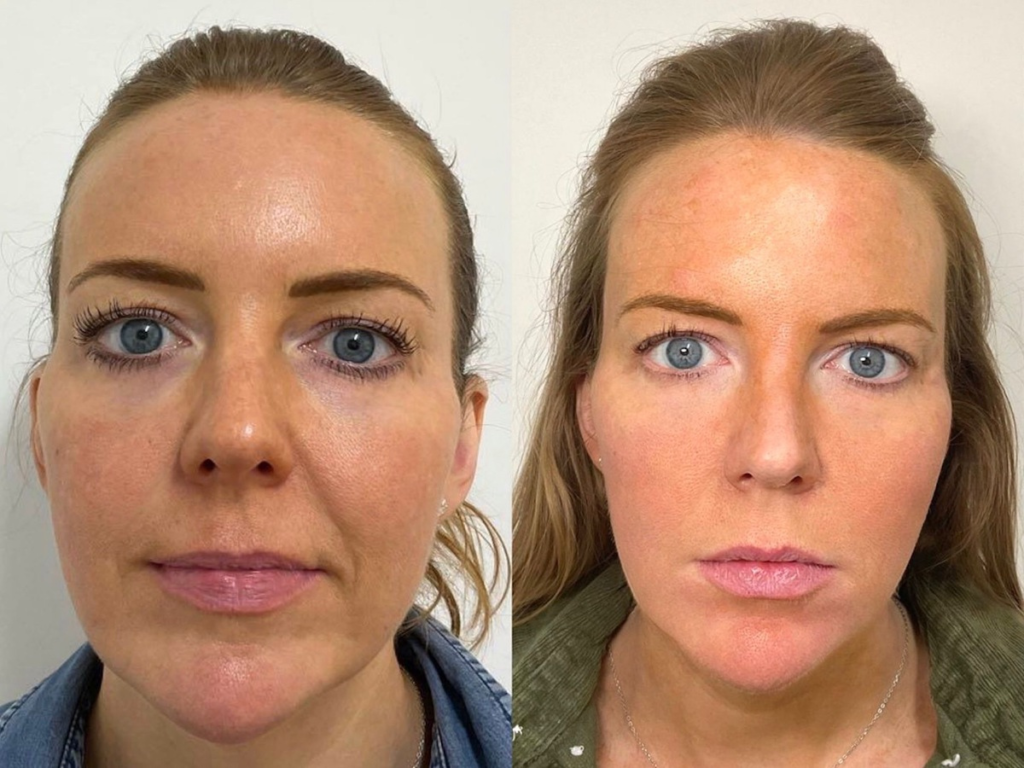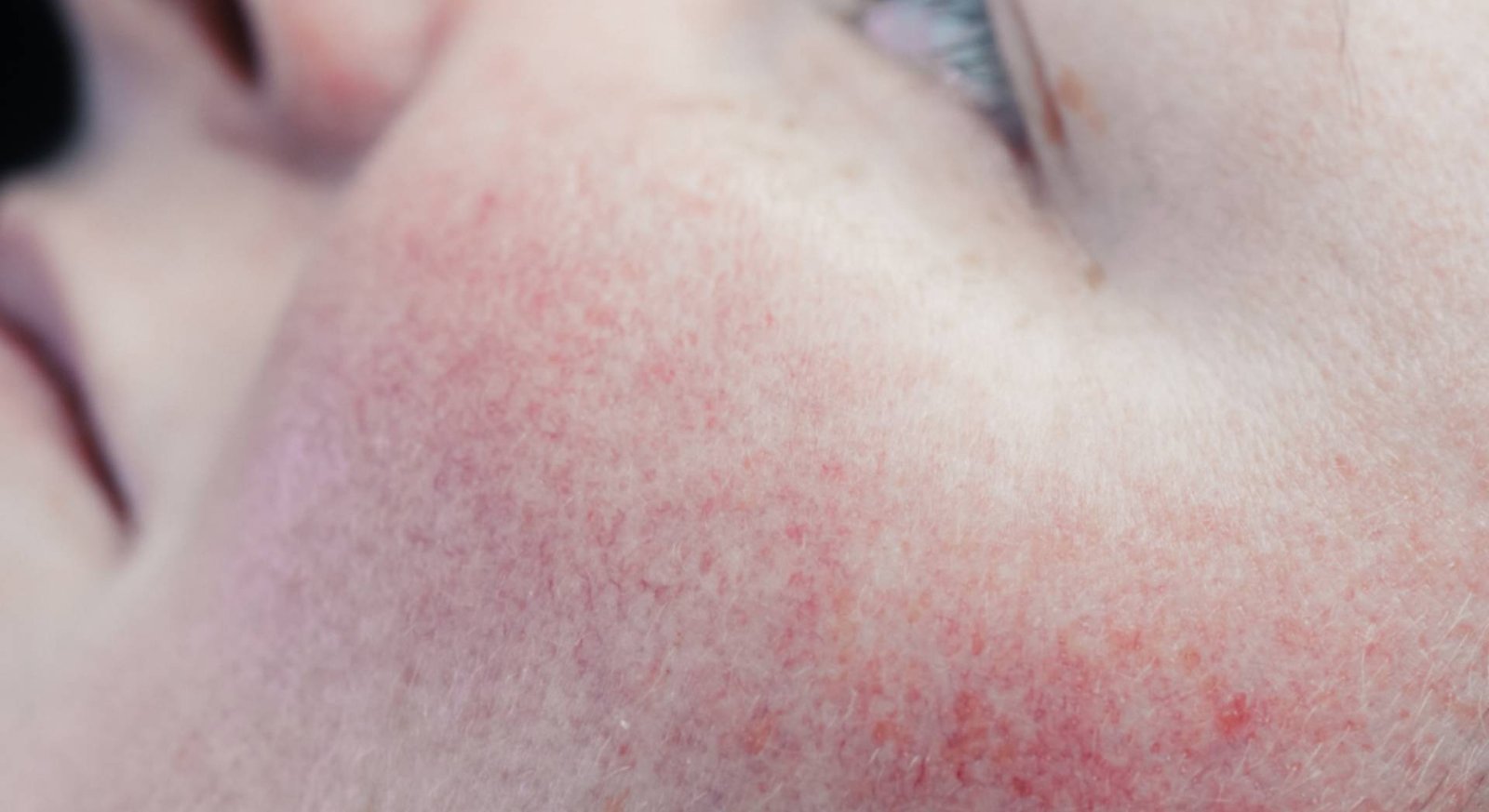
Ageing is a privilege that brings wisdom and experience, but it does not need to bring along intractable wrinkles and fine lines. The positive mental impact of feeling confident in your skin and appearance is well-documented. With well-established procedures available to maintain a youthful look, there’s no need to let your face reveal your age more than you want it to.
We comprehensively understand how our facial appearance evolves with age and how dermal fillers can preserve and enhance our facial aesthetics.
Ageing is caused by a combination of microscopic and macroscopic volumetric changes, including the resorption of bony structures and the redistribution of subcutaneous fat, with gravitational effects, sun exposure, heredity, and lifestyle also contribute to this process [2] [13].
This leads to facial muscles working closer to the skin surface causing lines on the face to be more apparent [2].
Another significant contributor to the ageing process is the loss of collagen, an essential protein found extensively throughout our body—including the skin, muscles, bones, and connective tissue—which diminishes as we age [7]. A variety of intrinsic and extrinsic factors degrades the structural integrity of the dermis, with enzymatic degradation of collagen by metalloproteinases and the subsequent death of fibroblasts [13].
Reduced collagen levels in the skin lead to increased laxity and volume loss, causing the skin to become thinner, lose its elasticity, and begin to sag [7]. Clinically, this can be seen in the form of wrinkles, atrophy, elastosis, dyschromia, and volume loss [5].
To align with the aesthetic concept of beauty, dermal filler treatment, a non-surgical cosmetic procedure is used to enhance an individual’s look by correcting certain contours and dimensions of their facial features [7][13].
Dermal fillers are a safe and relatively affordable treatment using gel-like, biodegradable dermal fillers to rejuvenate the face [11][13]. Administered by a licensed aesthetic practitioner, dermal fillers are a non-permanent injectable treatment. [11][13].
This is a cosmetic procedure that typically takes 30 to 40 minutes, usually with minimal recovery time [7][12]. The aim is to add fullness to the thinning areas around the cheeks, lips, and mouth by restoring volumetric dimensions, and enhancing the facial features by plumping up wrinkles, improving the appearance of facial lines, and softening any creases giving the face a fuller and more youthful appearance [1][4][12][13].
Carefully placed appropriate dermal fillers can also mimic lost bone. Dermal fillers generally last 12-18 months though some semipermanent agents will last longer [6]. For the safest and most commonly used temporary dermal fillers, ongoing treatments are needed for long-lasting results [2].
Dermal fillers, commonly known as “wrinkle fillers,” go beyond smoothing wrinkles and are designed to address various signs of ageing [1][4].
Your aesthetic doctor should lay out and discuss the different options available.
Like any cosmetic procedure, dermal filler injections carry risks such as infection, bleeding, and bruising and because it’s an elective cosmetic procedure, dermal fillers are typically not covered by health insurance plans [7]. Depending on this information, the dermal filler you select may:
- Add volume to sagging skin leading to rejuvenated skin such as on the hands
- Restore volume to sunken cheeks or temples giving lift to the cheekbones
- Plump and enhance lips, cheeks, and chin and diminishing vertical lip lines and chin creases
- Smooth wrinkles, lines, creases, and skin folds around the nose and mouth (marionette lines, smile lines, parentheses)
- Fill in shallow areas, recessed scars, and under-eye shadows and improve their appearance
- Reconstruct facial contour deformities
- Enhance facial symmetry
Dermal fillers are classified as medical devices in the UK and are regulated by the Medical and Healthcare Products Regulatory Agency (MHRA) [10]. To enhance patient safety, an All-Party Parliamentary Group (APPG) recommended in 2021 that dermal fillers in the UK should be made prescription-only but this recommendation has yet to be implemented [9]. In the same year, however, the Botulinum Toxin and Cosmetic Fillers (Children) Act made it a criminal offence in the UK to administer injectable toxins or fillers for cosmetic reasons to any individual under the age of 18 [8].
The concern around improving patient safety was revisited by the UK government in the long-anticipated Aesthetics Licensing Scheme Proposal published by the Department of Health & Social Care (DHSC) which suggested tightening regulations on dermal fillers [10]. Although this proposal still awaits implementation there is hope for it in the near future. [10].
The composition of the most commonly used hyaluronic acid dermal fillers is such that our body eventually breaks them down [12]. As a result, this temporary procedure must be repeated to maintain the desired aesthetic effect [12]. It is recommended to get your dermal filler procedure from a medically qualified aesthetic practitioner using brand-name dermal fillers [1].
Substances used in temporary dermal fillers include the following materials:


HYALURONIC ACID (HA)
Hyaluronic acid (HA) is a naturally occurring substance in the fluids and tissues of our body that adds volume to our skin and keeps it hydrated [4][7]. Found in high concentrations in soft connective tissue, the fluid around the eyes, and cartilage and joint tissues, HA is extracted and reformulated for use as an injectable dermal filler [2]. As we age, our bodies produce less HA, making these dermal fillers an effective solution to restore volume and hydration [7].
HA dermal fillers give a natural appearance due to their soft and gel-like texture [11]. They reduce depressions caused on the skin by scars, injuries, or wrinkles [2]. They are infused with lidocaine, a numbing agent, to minimize discomfort throughout the treatment process [1]. The results of HA dermal fillers are temporary, lasting from 6 to 12 months depending on their specific formulation, after which the body naturally absorbs the particles [11]. They can be dissolved with a special solution in case of adverse effects or dissatisfaction with the results [11]. The most common HA dermal fillers include Restylane and Juvederm.
CALCIUM HYDROXYLAPATITE (CaHA)
Calcium hydroxylapatite (CaHA) is also a naturally occurring mineral-like compound found in human bones, biosynthetically produced to minimize the risk of allergic reactions [1][2]. Its microscopic particles are suspended in a smooth gel, producing dermal fillers that give very natural results [1]. CaHA dermal fillers enhance facial contours and improve volume [2]. Their thicker consistency makes them ideal for deeper wrinkles like nasolabial folds and frown lines [2]. These dermal fillers typically last for about 12 months [7]. Concerns about dermal filler side effects are valid, but CaHA dermal fillers do not migrate, and side effects are rare [2]. Additionally, they stimulate natural collagen production [1]. The most common CaHA dermal fillers include Radiesse.
POLY-L-LACTIC ACID (PLLA)
Poly-L-lactic acid (PLLA), often referred to as a “collagen stimulator,” is a biodegradable synthetic substance that encourages the skin to produce its own collagen [1][4][12]. Non-toxic and biocompatible, PLLA has been safely used as dissolvable stitches for over 40 years [1][2]. Unlike other dermal fillers, PLLA does not present immediate results; the dermal filler dissolves within a few days, stimulating the skin to rebuild its natural collagen [1][2]. Achieving desired results may require several sessions, with effects lasting up to two years with occasional touch-ups [1][11]. This semi-permanent dermal filler is particularly effective for treating deep facial wrinkles and nasolabial folds [2]. The most common PLLA dermal fillers include Sculptra.
POLYMETHYLMETHACRYLATE (PMMA)
Polymethylmethacrylate (PMMA) is a semi-permanent dermal filler used to treat regular wrinkles, scars, skin folds, and lip enhancement [2]. It is the only dermal filler not absorbed by the body, as it consists of synthetic, biocompatible, smooth plastic beads suspended in a bovine collagen solution injected just under the skin [1][12]. This provides volume and firmness to the skin, with full results appearing up to three months after treatment [2]. Injection of PMMA dermal fillers requires a skilled aesthetic doctor to avoid overfilling and ensure proper technique [2]. Potential complications include the formation of lumps or visibility under the skin [11]. The most common PMMA dermal fillers include Bellafill.
Each type of dermal filler has a unique texture, density, and injection depth and is designed to deal with specific concerns [1]. Softer dermal fillers are ideal for lips, while firmer ones can be used to enhance cheekbones [2][7]. It’s crucial to discuss your goals and expectations of your dermal filler results thoroughly with your aesthetic doctor before proceeding [7].
During the initial consultation, your doctor will review your medical history, guide you through the various types of dermal fillers, provide recommendations, listen to your concerns, and explain the procedure [7]. It’s important to consider dermal fillers’ costs, especially concerning their durability and the potential need for touch-ups [7]. When receiving the treatment, the aesthetic doctor will sanitize the area and apply a topical anaesthetic. They will then strategically inject a precise amount of dermal filler into the marked area [1]. Depending on the type of dermal filler, you will receive instructions on necessary precautions, aftercare, and follow-up appointments [1].
Though dermal filler procedures are generally considered safe, they do carry potential risks such as infection, numbness, asymmetry, lumps, rashes, and itching [4][7]. It is important to remain vigilant for a few days after the treatment, monitor for any such changes, and contact your doctor immediately if they occur.

Bibliography
- American Board Cosmetic Surgery. (n.d.). Injectable Fillers Guide. [online] Available at:
https://www.americanboardcosmeticsurgery.org/procedure-learning-center/non-surgical/injectable-fillers-guide/ - American Society of Plastic Surgeons. (n.d.). Dermal Fillers. [online] Available at:
https://www.plasticsurgery.org/cosmetic-procedures/dermal-fillers - Andrews, L., et al. (2023). Dermal fillers: History 101. Dermatological Reviews, 4, pp.82–85. doi:
https://doi.org/10.1002/der2.183 - Berry, J. (2023). What Is the Difference between Botox and Dermal fillers? [online] Medical News Today. Available at:
https://www.medicalnewstoday.com/articles/320510#takeaway - Cabral, L.R.B., et al. (2020). Effect of Hyaluronic Acid and Poly-L-Lactic Acid Dermal Fillers on Collagen Synthesis: An in vitro and in vivo Study. Clinical, Cosmetic and Investigational Dermatology, 13, pp.701–710. doi:
https://doi.org/10.2147/CCID.S266015 - Chan, L., Li, A. and Schlesinger, T. (2023). Permanent fillers—What is their role. Dermatological Reviews, 4. doi:
https://doi.org/10.1002/der2.189 - Cleveland Clinic. (2022). Dermal Fillers. [online] Available at:
https://my.clevelandclinic.org/health/treatments/22667-dermal-fillers - GOV.UK. (2023). The licensing of non-surgical cosmetic procedures in England. [online] Available at:
https://www.gov.uk/government/consultations/licensing-of-non-surgical-cosmetic-procedures/the-licensing-of-non-surgical-cosmetic-procedures-in-england - Harley Academy. (2021). Prescription Only Dermal Fillers. [online] Available at:
https://www.harleyacademy.com/aesthetic-medicine-articles/prescription-only-dermal-fillers/ - Harley Academy. (2023). Aesthetics Licensing Scheme Proposal Released. [online] Available at:
https://www.harleyacademy.com/aesthetic-medicine-articles/aesthetics-licensing-scheme-proposal-released - Liu, K. (2020). Dermal fillers: the good, the Bad and the Dangerous. [online] Harvard Health. Available at:
https://www.health.harvard.edu/blog/dermal-fillers-the-good-the-bad-and-the-dangerous-201907152561 - U.S. Food & Drug Administration. (2023). Dermal Filler Do’s and Don’ts for Wrinkles, Lips and More. [online] Available at:
https://www.fda.gov/consumers/consumer-updates/dermal-filler-dos-and-donts-wrinkles-lips-and-more - Wongprasert, P., Dreiss, C.A. and Murray, G. (2022). Evaluating hyaluronic acid dermal fillers: A critique of current characterization methods. Dermatologic Therapy, 35(6). doi:
https://doi.org/10.1111/dth.15453






